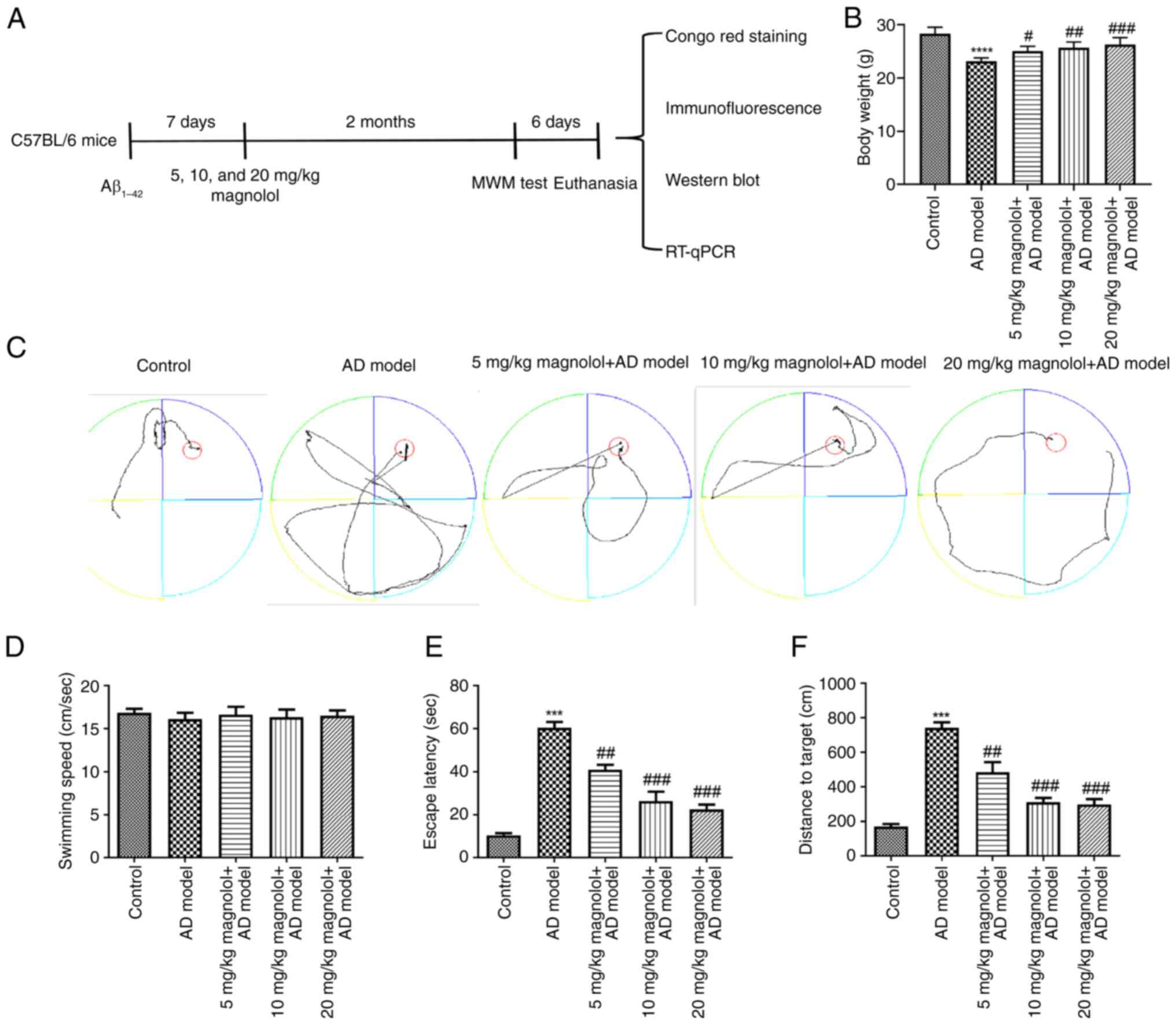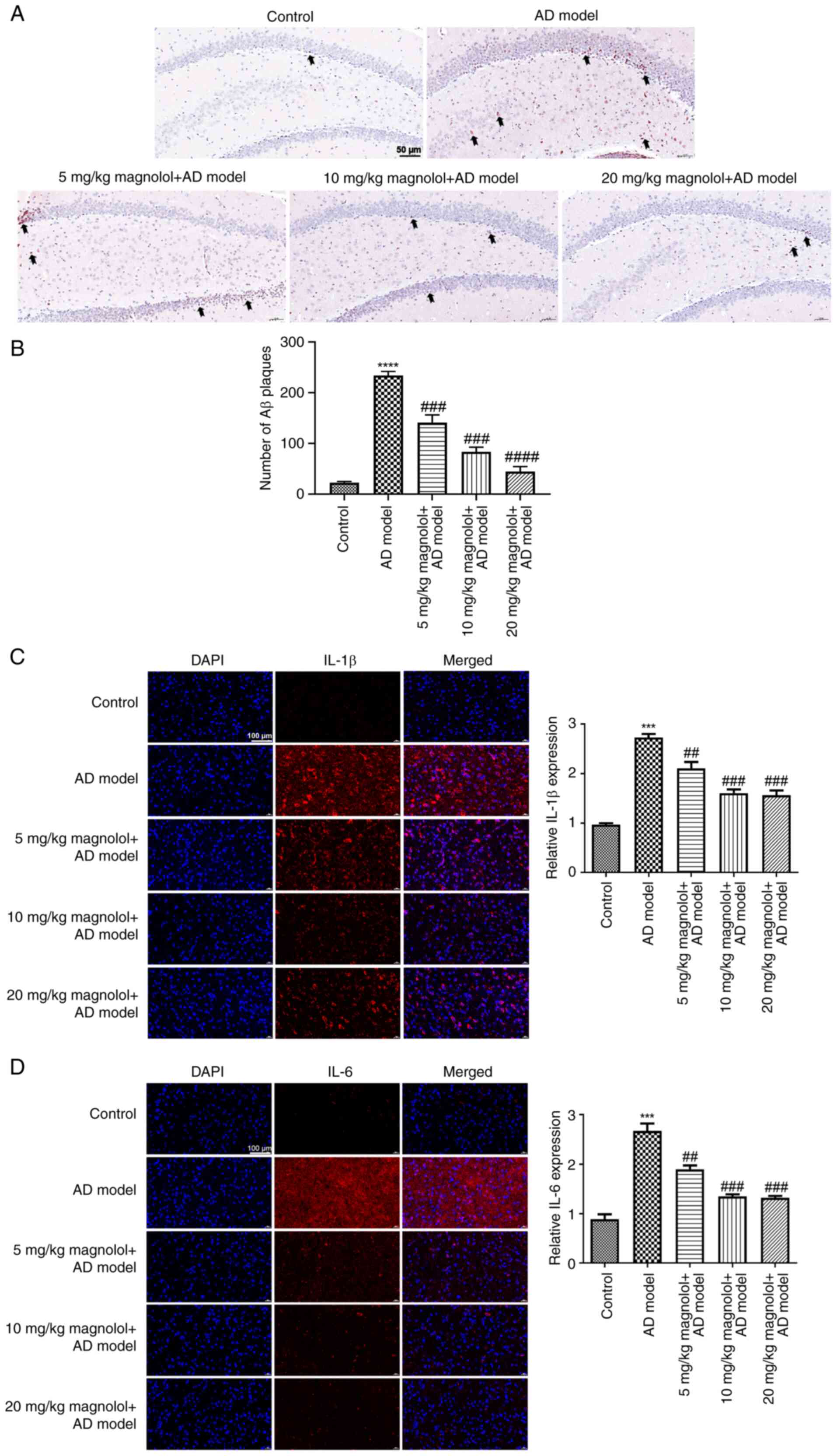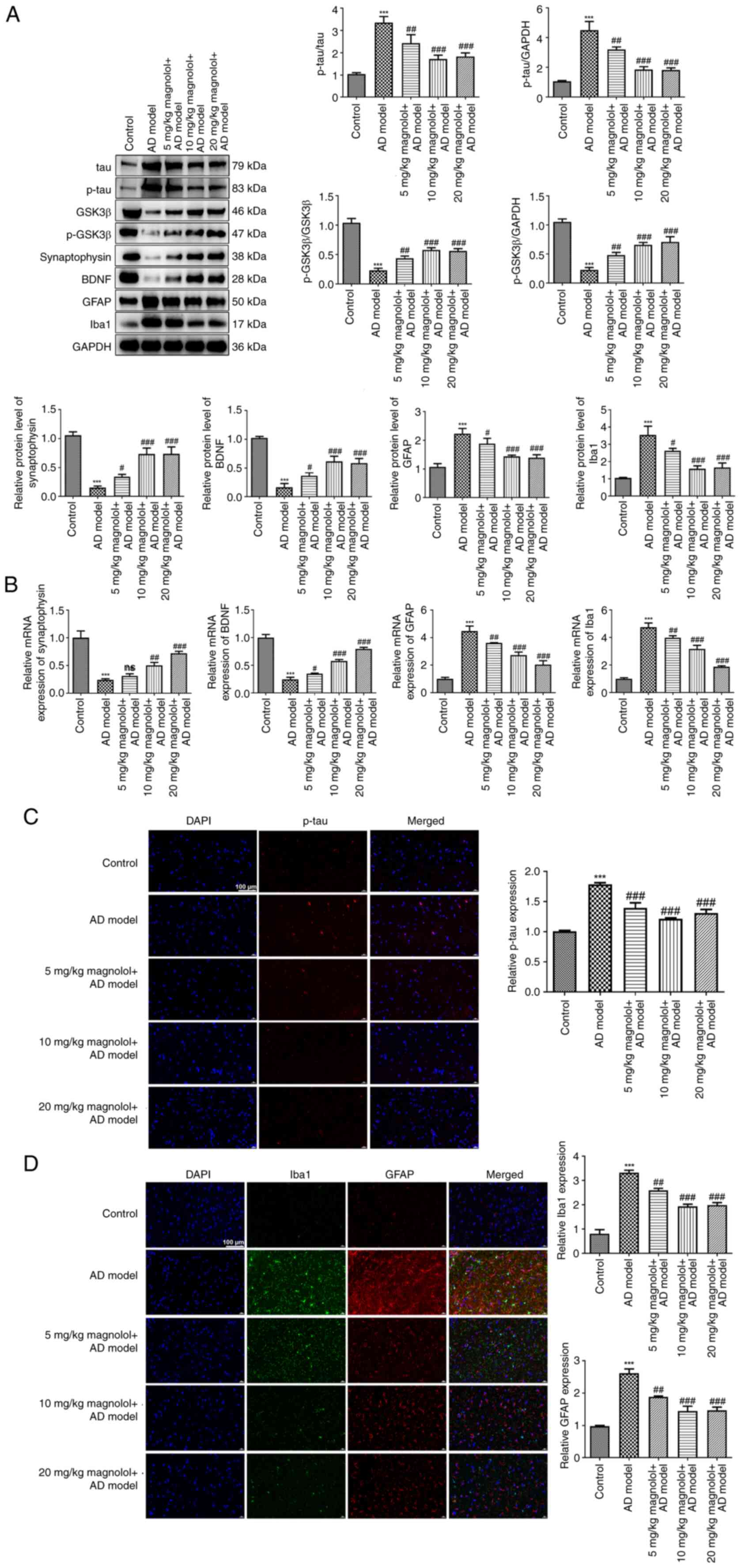|
1
|
Culig L, Chu X and Bohr VA: Neurogenesis
in aging and age-related neurodegenerative diseases. Ageing Res
Rev. 78(101636)2022.PubMed/NCBI View Article : Google Scholar
|
|
2
|
Joe E and Ringman JM: Cognitive symptoms
of Alzheimer's disease: Clinical management and prevention. BMJ.
367(l6217)2019.PubMed/NCBI View Article : Google Scholar
|
|
3
|
No authors listed. 2023 Alzheimer's
disease facts and figures. Alzheimers Dement. 19:1598–1695.
2023.PubMed/NCBI View Article : Google Scholar
|
|
4
|
Scheltens P, De Strooper B, Kivipelto M,
Holstege H, Chételat G, Teunissen CE, Cummings J and van der Flier
WM: Alzheimer's disease. Lancet. 397:1577–1590. 2021.PubMed/NCBI View Article : Google Scholar
|
|
5
|
Breijyeh Z and Karaman R: Comprehensive
review on Alzheimer's disease: Causes and treatment. Molecules.
25(5789)2020.PubMed/NCBI View Article : Google Scholar
|
|
6
|
Stefanoska K, Gajwani M, Tan ARP, Ahel HI,
Asih PR, Volkerling A, Poljak A and Ittner A: Alzheimer's disease:
Ablating single master site abolishes tau hyperphosphorylation. Sci
Adv. 8(eabl8809)2022.PubMed/NCBI View Article : Google Scholar
|
|
7
|
Mandlik DS, Mandlik SK and S A:
Therapeutic implications of glycogen synthase kinase-3β in
Alzheimer's disease: A novel therapeutic target. Int J Neurosci.
134:603–619. 2024.PubMed/NCBI View Article : Google Scholar
|
|
8
|
Utz J, Berner J, Muñoz LE, Oberstein TJ,
Kornhuber J, Herrmann M, Maler JM and Spitzer P: Cerebrospinal
fluid of patients with Alzheimer's disease contains increased
percentages of synaptophysin-bearing microvesicles. Front Aging
Neurosci. 13(682115)2021.PubMed/NCBI View Article : Google Scholar
|
|
9
|
Gao L, Zhang Y, Sterling K and Song W:
Brain-derived neurotrophic factor in Alzheimer's disease and its
pharmaceutical potential. Transl Neurodegener. 11(4)2022.PubMed/NCBI View Article : Google Scholar
|
|
10
|
Thakur S, Dhapola R, Sarma P, Medhi B and
Reddy DH: Neuroinflammation in Alzheimer's disease: Current
progress in molecular signaling and therapeutics. Inflammation.
46:1–17. 2023.PubMed/NCBI View Article : Google Scholar
|
|
11
|
Li Y, Schindler SE, Bollinger JG, Ovod V,
Mawuenyega KG, Weiner MW, Shaw LM, Masters CL, Fowler CJ,
Trojanowski JQ, et al: Validation of plasma amyloid-β 42/40 for
detecting Alzheimer disease amyloid plaques. Neurology.
98:e688–e699. 2022.PubMed/NCBI View Article : Google Scholar
|
|
12
|
Bloom GS: Amyloid-β and tau: The trigger
and bullet in Alzheimer disease pathogenesis. JAMA Neurol.
71:505–508. 2014.PubMed/NCBI View Article : Google Scholar
|
|
13
|
Selkoe DJ and Hardy J: The amyloid
hypothesis of Alzheimer's disease at 25 years. EMBO Mol Med.
8:595–608. 2016.PubMed/NCBI View Article : Google Scholar
|
|
14
|
Silva MVF, Loures CMG, Alves LCV, de Souza
LC, Borges KBG and Carvalho MDG: Alzheimer's disease: Risk factors
and potentially protective measures. J Biomed Sci.
26(33)2019.PubMed/NCBI View Article : Google Scholar
|
|
15
|
Graham WV, Bonito-Oliva A and Sakmar TP:
Update on Alzheimer's disease therapy and prevention strategies.
Annu Rev Med. 68:413–430. 2017.PubMed/NCBI View Article : Google Scholar
|
|
16
|
Maione F, Piccolo M, De Vita S, Chini MG,
Cristiano C, De Caro C, Lippiello P, Miniaci MC, Santamaria R,
Irace C, et al: Down regulation of pro-inflammatory pathways by
tanshinone IIA and cryptotanshinone in a non-genetic mouse model of
Alzheimer's disease. Pharmacol Res. 129:482–490. 2018.PubMed/NCBI View Article : Google Scholar
|
|
17
|
Ben-Azu B, Nwoke EE, Aderibigbe AO,
Omogbiya IA, Ajayi AM, Olonode ET, Umukoro S and Iwalewa EO:
Possible neuroprotective mechanisms of action involved in the
neurobehavioral property of naringin in mice. Biomed Pharmacother.
109:536–546. 2019.PubMed/NCBI View Article : Google Scholar
|
|
18
|
Jha AB, Panchal SS and Shah A: Ellagic
acid: Insights into its neuroprotective and cognitive enhancement
effects in sporadic Alzheimer's disease. Pharmacol Biochem Behav.
175:33–46. 2018.PubMed/NCBI View Article : Google Scholar
|
|
19
|
Ai-Ping M, Heng-Chang W, Jian-Qiang LI and
Yong-Kang S: A karyomorphological study of 40 species in 11 genera
of the Magnoliaceae from China. J Syst Evol. 44:47–63. 2006.
|
|
20
|
Parray HA, Lone J, Park JP, Choi JW and
Yun JW: Magnolol promotes thermogenesis and attenuates oxidative
stress in 3T3-L1 adipocytes. Nutrition. 50:82–90. 2018.PubMed/NCBI View Article : Google Scholar
|
|
21
|
Chen S, Shen J, Zhao J, Wang J, Shan T, Li
J, Xu M, Chen X, Liu Y and Cao G: Magnolol suppresses pancreatic
cancer development in vivo and in vitro via negatively regulating
TGF-β/Smad signaling. Front Oncol. 10(597672)2020.PubMed/NCBI View Article : Google Scholar
|
|
22
|
Chen Y, Chen S, Chen K, Ji L and Cui S:
Magnolol and 5-fluorouracil synergy inhibition of metastasis of
cervical cancer cells by targeting PI3K/AKT/mTOR and EMT pathways.
Chin Herb Med. 16:94–105. 2023.PubMed/NCBI View Article : Google Scholar
|
|
23
|
He NN, Wang JA, Huang D, Sun XL, Ding F,
Zhao L, Zhang YX, Li HM and Wu CZ: Semisynthesis and in vitro
anti-cancer effect of new magnolol derivatives on the cell
proliferation, apoptosis, migration, and invasion of human
hepatocellular carcinoma SMMC-7721 cells. Chem Pharm Bull (Tokyo).
71:798–803. 2023.PubMed/NCBI View Article : Google Scholar
|
|
24
|
Liu CM, Chen SH, Liao YW, Yu CH, Yu CC and
Hsieh PL: Magnolol ameliorates the accumulation of reactive
oxidative stress and inflammation in diabetic periodontitis. J
Formos Med Assoc. 120:1452–1458. 2021.PubMed/NCBI View Article : Google Scholar
|
|
25
|
Wang X and Jia J: Magnolol improves
Alzheimer's disease-like pathologies and cognitive decline by
promoting autophagy through activation of the AMPK/mTOR/ULK1
pathway. Biomed Pharmacother. 161(114473)2023.PubMed/NCBI View Article : Google Scholar
|
|
26
|
Chen T, Shou L, Guo X, Wei M, Zheng H and
Tao T: Magnolol attenuates the locomotor impairment, cognitive
deficit, and neuroinflammation in Alzheimer's disease mice with
brain insulin resistance via up-regulating miR-200c. Bioengineered.
13:531–543. 2022.PubMed/NCBI View Article : Google Scholar
|
|
27
|
Zhu G, Fang Y, Cui X, Jia R, Kang X and
Zhao R: Magnolol upregulates CHRM1 to attenuate amyloid-β-triggered
neuronal injury through regulating the cAMP/PKA/CREB pathway. J Nat
Med. 76:188–199. 2022.PubMed/NCBI View Article : Google Scholar
|
|
28
|
Talwar P, Sinha J, Grover S, Rawat C,
Kushwaha S, Agarwal R, Taneja V and Kukreti R: Dissecting complex
and multifactorial nature of Alzheimer's disease pathogenesis: A
clinical, genomic, and systems biology perspective. Mol Neurobiol.
53:4833–4864. 2016.PubMed/NCBI View Article : Google Scholar
|
|
29
|
Ferrari C and Sorbi S: The complexity of
Alzheimer's disease: An evolving puzzle. Physiol Rev.
101:1047–1081. 2021.PubMed/NCBI View Article : Google Scholar
|
|
30
|
Calvo-Flores Guzmán B, Elizabeth Chaffey
T, Hansika Palpagama T, Waters S, Boix J, Tate WP, Peppercorn K,
Dragunow M, Waldvogel HJ, Faull RLM and Kwakowsky A: The interplay
between beta-amyloid 1-42 (Aβ1-42)-induced hippocampal
inflammatory response, p-tau, vascular pathology, and their
synergistic contributions to neuronal death and behavioral
deficits. Front Mol Neurosci. 13(522073)2020.PubMed/NCBI View Article : Google Scholar
|
|
31
|
Wang LS, Tao X, Liu XM, Zhou YF, Zhang MD,
Liao YH, Pan RL and Chang Q: Cajaninstilbene acid ameliorates
cognitive impairment induced by intrahippocampal injection of
amyloid-β1-42 oligomers. Front Pharmacol.
10(1084)2019.PubMed/NCBI View Article : Google Scholar
|
|
32
|
Baerends E, Soud K, Folke J, Pedersen AK,
Henmar S, Konrad L, Lycas MD, Mori Y, Pakkenberg B, Woldbye DPD, et
al: Modeling the early stages of Alzheimer's disease by
administering intracerebroventricular injections of human native Aβ
oligomers to rats. Acta Neuropathol Commun. 10(113)2022.PubMed/NCBI View Article : Google Scholar
|
|
33
|
National Research Council (US) Committee
for the Update of the Guide for the Care and Use of Laboratory
Animals: Guide for the care and use of laboratory animals, 8th
edition. Washington (DC): National Academies Press (US), 2011.
|
|
34
|
Rahman SO, Kaundal M, Salman M,
Shrivastava A, Parvez S, Panda BP, Akhter M, Akhtar M and Najmi AK:
Alogliptin reversed hippocampal insulin resistance in an
amyloid-beta fibrils induced animal model of Alzheimer's disease.
Eur J Pharmacol. 889(173522)2020.PubMed/NCBI View Article : Google Scholar
|
|
35
|
Elibol B, Beker M, Terzioglu-Usak S, Dalli
T and Kilic U: Thymoquinone administration ameliorates Alzheimer's
disease-like phenotype by promoting cell survival in the
hippocampus of amyloid beta1-42 infused rat model.
Phytomedicine. 79(153324)2020.PubMed/NCBI View Article : Google Scholar
|
|
36
|
Livak KJ and Schmittgen TD: Analysis of
relative gene expression data using real-time quantitative PCR and
the 2(-Delta Delta C(T)) method. Methods. 25:402–408.
2001.PubMed/NCBI View Article : Google Scholar
|
|
37
|
Lana D, Ugolini F, Nosi D, Wenk GL and
Giovannini MG: The emerging role of the interplay among astrocytes,
microglia, and neurons in the hippocampus in health and disease.
Front Aging Neurosci. 13(651973)2021.PubMed/NCBI View Article : Google Scholar
|
|
38
|
Sharma K, Pradhan S, Duffy LK, Yeasmin S,
Bhattarai N and Schulte MK: Role of receptors in relation to
plaques and tangles in Alzheimer's disease pathology. Int J Mol
Sci. 22(12987)2021.PubMed/NCBI View Article : Google Scholar
|
|
39
|
Andrade-Talavera Y and Rodriguez-Moreno A:
Synaptic plasticity and oscillations in Alzheimer's disease: A
complex picture of a multifaceted disease. Front Mol Neurosci.
14(696476)2021.PubMed/NCBI View Article : Google Scholar
|
|
40
|
Deng Q, Wu C, Parker E, Liu TC, Duan R and
Yang L: Microglia and astrocytes in Alzheimer's disease:
Significance and summary of recent advances. Aging Dis.
15:1537–1564. 2024.PubMed/NCBI View Article : Google Scholar
|
|
41
|
Yan T, Liu B, Wang N, Liao Z, Wu B, He B
and Jia Y: The flavonoids of okra insulates against oxidative
stress, neuroinflammation and restores BDNF levels in
Aβ1-42 induced mouse model of Alzheimer's disease. Exp
Gerontol. 147(111263)2021.PubMed/NCBI View Article : Google Scholar
|
|
42
|
Souza LC, Jesse CR, Del Fabbro L, de Gomes
MG, Gomes NS, Filho CB, Goes ATR, Wilhelm EA, Luchese C, Roman SS
and Boeira SP: Aging exacerbates cognitive and anxiety alterations
induced by an intracerebroventricular injection of
amyloid-β1-42 peptide in mice. Mol Cell Neurosci.
88:93–106. 2018.PubMed/NCBI View Article : Google Scholar
|
|
43
|
Giacomeli R, Izoton JC, Dos Santos RB,
Boeira SP, Jesse CR and Haas SE: Neuroprotective effects of
curcumin lipid-core nanocapsules in a model Alzheimer's disease
induced by β-amyloid 1-42 peptide in aged female mice. Brain Res.
1721(146325)2019.PubMed/NCBI View Article : Google Scholar
|
|
44
|
Liu Y, Xu S, Bian H, Qian Y, Li H, Shu S,
Chen J, Cao X, Gu Y, Jin J, et al: Xingnaojing ameliorates synaptic
plasticity and memory deficits in an Aβ1-42 induced
mouse model of Alzheimer's disease. J Pharmacol Sci. 143:245–254.
2020.PubMed/NCBI View Article : Google Scholar
|
|
45
|
Huang W, Li Z, Zhao L and Zhao W:
Simvastatin ameliorate memory deficits and inflammation in clinical
and mouse model of Alzheimer's disease via modulating the
expression of miR-106b. Biomed Pharmacother. 92:46–57.
2017.PubMed/NCBI View Article : Google Scholar
|
|
46
|
Yang Y, Ji WG, Zhang YJ, Zhou LP, Chen H,
Yang N and Zhu ZR: Riluzole ameliorates soluble
Aβ1-42-induced impairments in spatial memory by
modulating the glutamatergic/GABAergic balance in the dentate
gyrus. Prog Neuropsychopharmacol Biol Psychiatry.
108(110077)2021.PubMed/NCBI View Article : Google Scholar
|
|
47
|
Chen Q, Yin Y, Li L, Zhang Y, He W and Shi
Y: Milrinone ameliorates the neuroinflammation and memory function
of Alzheimer's disease in an APP/PS1 mouse model. Neuropsychiatr
Dis Treat. 17:2129–2139. 2021.PubMed/NCBI View Article : Google Scholar
|
|
48
|
Arabi A, Karimi SA, Salehi I, Haddadi R
and Komaki A: Effects of sesamin on Aβ1-42-induced
oxidative stress and LTP impairment in a rat model of Alzheimer's
disease. Metab Brain Dis. 38:1503–1511. 2023.PubMed/NCBI View Article : Google Scholar
|
|
49
|
Twarowski B and Herbet M: Inflammatory
processes in Alzheimer's disease-pathomechanism, diagnosis and
treatment: A review. Int J Mol Sci. 24(6518)2023.PubMed/NCBI View Article : Google Scholar
|
|
50
|
Thal DR and Tomé SO: The central role of
tau in Alzheimer's disease: From neurofibrillary tangle maturation
to the induction of cell death. Brain Res Bull. 190:204–217.
2022.PubMed/NCBI View Article : Google Scholar
|
|
51
|
Sayas CL and Ávila J: GSK-3 and tau: A key
duet in Alzheimer's disease. Cells. 10(721)2021.PubMed/NCBI View Article : Google Scholar
|
|
52
|
Ochs SM, Dorostkar MM, Aramuni G, Schön C,
Filser S, Pöschl J, Kremer A, Van Leuven F, Ovsepian SV and Herms
J: Loss of neuronal GSK3β reduces dendritic spine stability and
attenuates excitatory synaptic transmission via β-catenin. Mol
Psychiatry. 20:482–489. 2015.PubMed/NCBI View Article : Google Scholar
|
|
53
|
Cuestas Torres DM and Cardenas FP:
Synaptic plasticity in Alzheimer's disease and healthy aging. Rev
Neurosci. 31:245–268. 2020.PubMed/NCBI View Article : Google Scholar
|
|
54
|
Liu E, Xie AJ, Zhou Q, Li M, Zhang S, Li
S, Wang W, Wang X, Wang Q and Wang JZ: GSK-3β deletion in dentate
gyrus excitatory neuron impairs synaptic plasticity and memory. Sci
Rep. 7(5781)2017.PubMed/NCBI View Article : Google Scholar
|
|
55
|
Lu B, Nagappan G, Guan X, Nathan PJ and
Wren P: BDNF-based synaptic repair as a disease-modifying strategy
for neurodegenerative diseases. Nat Rev Neurosci. 14:401–416.
2013.PubMed/NCBI View Article : Google Scholar
|
|
56
|
Chen Y and Colonna M: Microglia in
Alzheimer's disease at single-cell level. Are there common patterns
in humans and mice? J Exp Med. 218(e20202717)2021.PubMed/NCBI View Article : Google Scholar
|













